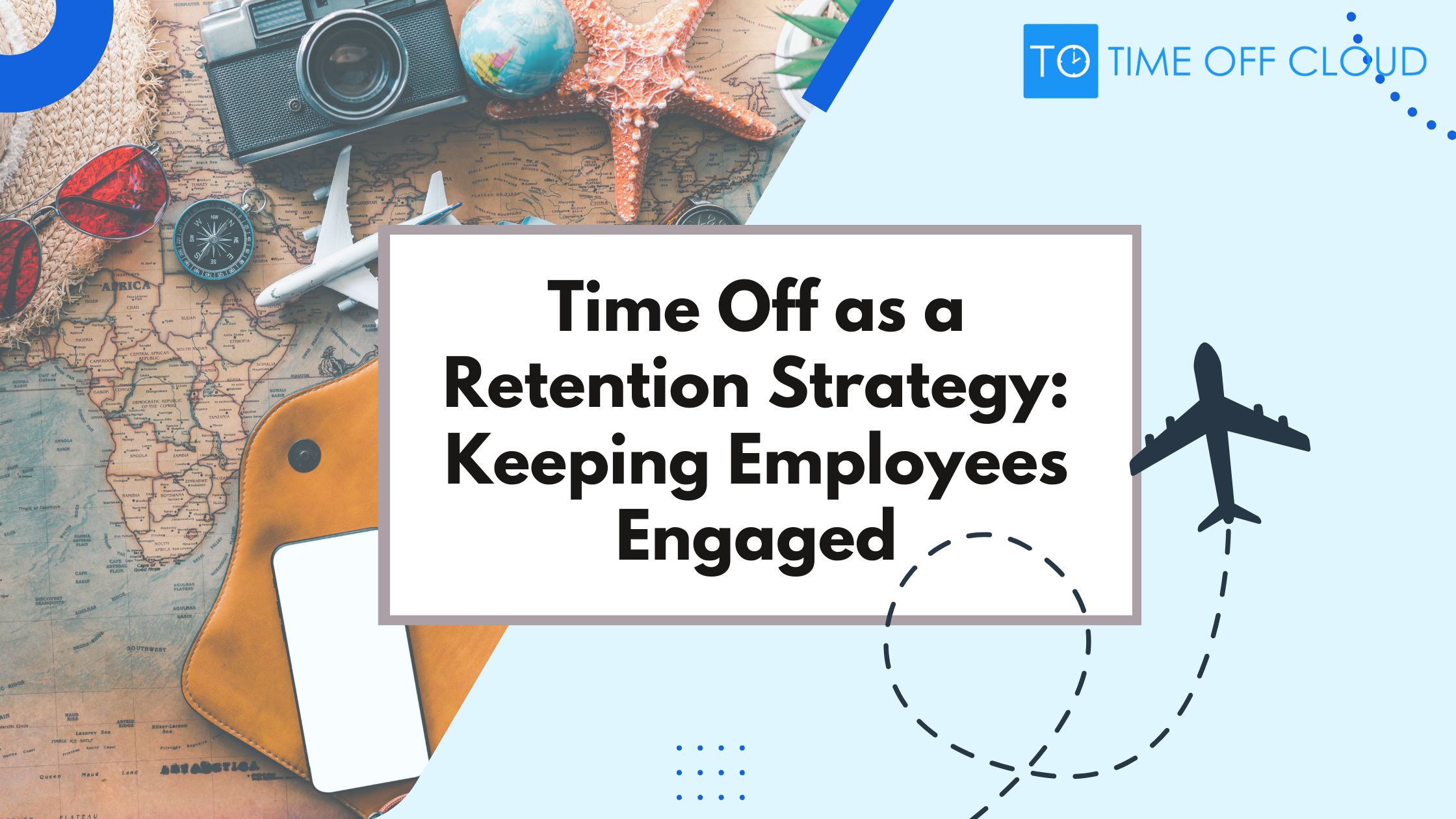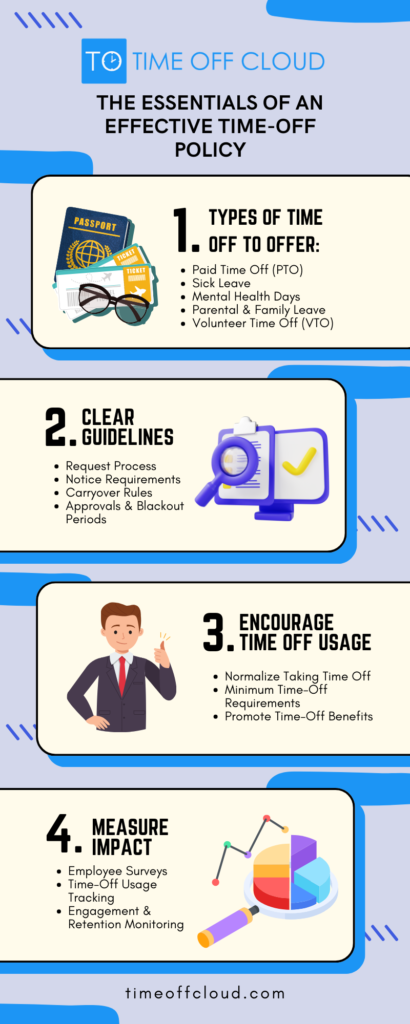Employee retention is a major challenge for many organizations. In fact, the average annual turnover rate in the U.S. is around 23%, and over 30% of employees leave within the first 90 days. One powerful yet often overlooked tool for retaining talent is offering well-structured time off. Employees who feel supported in their need for rest, relaxation, and personal time are more likely to stay engaged, motivated, and loyal to their company. In this post from Time Off Cloud, we’ll explore the importance of time off as a retention strategy and how it can keep employees engaged for the long term.
The Role of Time Off in Employee Well-Being
Providing employees with ample and flexible time off plays a crucial role in their overall well-being. Time away from work gives employees the opportunity to rest, recharge, and maintain a healthy work-life balance. Neglecting this aspect can lead to burnout, decreased productivity, and ultimately higher turnover rates.
Preventing Burnout
Burnout is one of the primary reasons employees leave their jobs. According to a Gallup study, 76% of employees experience burnout on the job at least sometimes, with 28% reporting feeling burned out “very often” or “always.” When employees are overworked without sufficient time to rest, they can experience mental and physical exhaustion, diminishing their passion for their work. By offering regular time off and encouraging its use, you can help employees manage stress and stay engaged with their responsibilities.
Promoting Mental Health
Supporting employees’ mental health is critical for retention, and time off is a key factor in this. Allowing employees to take mental health days, whether planned or spontaneous, shows that you value their well-being. This contributes to a positive work culture, where employees feel cared for and more likely to stay with the company.
Time Off as a Competitive Advantage in Retention
Offering generous and flexible time-off policies is an attractive benefit that can set your organization apart from competitors. It’s not just about providing vacation days—modern employees are looking for companies that offer personalized, flexible time-off options that fit their needs.
Offering Flexible Time Off Options
Different employees have different time-off needs, and offering flexibility is a great way to cater to them. This might include:
- Unlimited Paid Time Off (PTO): Trusting employees to manage their own time fosters autonomy and responsibility.
- Flexible Holidays: Allowing employees to choose which holidays to take off makes time off more inclusive for those with different cultural or religious backgrounds.
- Sabbaticals: Offering extended breaks for employees who have been with the company for a long time encourages loyalty and allows employees to pursue personal growth.
Encouraging the Use of Time Off
Even when companies provide generous time off, many employees hesitate to use it. Whether due to a fear of falling behind or feeling pressured to stay at work, some employees may neglect to take the time they need. Encouraging the use of time off is critical to ensuring it acts as a true retention strategy.
Setting the Example from the Top
Leaders play a crucial role in fostering a culture where taking time off is not only accepted but encouraged. When managers and executives lead by example and regularly take time off, it normalizes the practice for all employees. It sends a clear message that rest and work-life balance are valued at every level of the organization.
Creating a Supportive Culture
Building a supportive culture around time off involves more than just offering days away from the office. It’s about creating an environment where employees feel safe to take time off without fear of judgment or workload pressure. Establish clear policies that encourage time off, ensure employees can disconnect fully during their breaks, and avoid rewarding those who stay at work at the expense of their well-being.
Time Off to Foster Engagement and Creativity
Employees who are well-rested are more engaged, productive, and creative. In fact, research from the Harvard Business Review found that well-rested employees are 31% more productive and 3 times more creative. Time off gives employees the chance to step away from their day-to-day responsibilities and return to work with fresh perspectives and new ideas. This boost in creativity and engagement contributes to job satisfaction, which is directly linked to retention.
Boosting Productivity Through Rest
It’s a common misconception that taking time off reduces productivity. In reality, employees who take regular breaks come back to work more focused and efficient. The time away allows them to recharge and return with renewed energy to tackle tasks and projects with greater enthusiasm.
Encouraging Innovation with Downtime
Time off can also spur innovation. When employees have the opportunity to step away from their routines, they are more likely to think creatively and approach problems with a fresh perspective. This not only benefits the company through new ideas but also keeps employees engaged in their work.
The Long-Term Benefits of Time Off for Employee Retention
Investing in time-off policies is a long-term strategy for employee retention. Employees who feel their time and well-being are respected are more likely to stay with a company, perform better, and contribute positively to the company culture.
Reducing Turnover Costs
Employee turnover is expensive, both in terms of financial costs and lost productivity. Replacing an employee can cost as much as 1.5 to 2 times their annual salary. By offering time off as part of your retention strategy, you can reduce these costs and maintain a more stable workforce.
Building Loyalty and Trust
Time off is more than a benefit; it’s a way to build loyalty and trust with your employees. When you support their well-being and demonstrate that you value their time, they are more likely to return that investment with loyalty to your company. This trust-based relationship is the foundation of long-term retention.
Best Practices for Implementing Effective Time-Off Policies
Creating a well-structured time-off policy is essential for ensuring that employees feel supported and can take the time they need to recharge. When designed thoughtfully, these policies can improve employee well-being, boost retention, and maintain productivity. Below are some best practices that can be used to implement an effective time-off policy that benefits both employees and the organization.
Offer a Variety of Time-Off Options
A comprehensive time-off policy should include different types of leave to address a variety of employee needs. Consider offering:
- Paid Time Off (PTO): A flexible PTO system allows employees to take time off as needed for personal, medical, or vacation reasons without requiring separate categories for each.
- Sick Leave: Ensure employees feel comfortable taking time off when they’re sick without fear of losing pay or using up vacation days.
- Mental Health Days: Offering specific mental health days shows a commitment to employee well-being and helps reduce burnout.
- Volunteer Time Off (VTO): Allowing employees to take time off to participate in community service can enhance engagement and promote company values.
Set Clear Guidelines and Expectations
Employees need to understand how your time-off policy works and what is expected of them. Clear communication can help avoid confusion and ensure fairness. Make sure your policy includes:
- How to Request Time Off: Provide a simple, accessible process for requesting time off, such as through a dedicated software tool.
- Advance Notice Requirements: Specify how much advance notice is needed for different types of leave (e.g., vacation vs. emergency sick leave).
- Carryover and Rollover Rules: Explain whether unused PTO can carry over to the next year and any limits on how much can be rolled over.
- Approvals and Blackout Periods: Outline how time-off requests are approved and any periods where leave may be restricted due to business needs.
Measure the Impact of Your Time-Off Policy
To ensure that your time-off policies are having the desired effect on employee retention and well-being, it’s important to measure their impact. You can do this by:
- Conduct Employee Surveys: Periodically ask employees about their satisfaction with the time-off policy and whether they feel it meets their needs.
- Track Time-Off Usage: Use HR software to track how much time employees are taking off and identify any patterns that may signal overwork or burnout.
- Monitor Employee Engagement and Retention: Correlate time-off usage with employee engagement scores and retention rates to see if there’s a positive impact.
Download this infographic for quick, accessible guidance for crafting a time off policy:
Contact Time Off Cloud for Employee Time-Off Solutions
Managing employee time off effectively is crucial for retention and engagement. Time Off Cloud offers a comprehensive platform that streamlines leave management, ensuring your employees can easily request time off, track their days, and stay in compliance with company policies. By using our tools, you can support your employees’ well-being and strengthen your retention strategy. Contact us now to get started, or schedule your free trial now.



